Surfing is a surface water sport in which the wave rider, referred to as a "surfer", rides on the forward face of a wave, which is most often carrying the surfer towardsshore. Waves suitable for surfing are primarily found in the ocean, but can also be found in lakes or in rivers in the form of a standing wave or tidal bore. However, modern day Surfing can also be done in man-made sources such as wave pools and boat wakes.
The term "surfing" refers to the act of riding a wave and not the form (with or without a board) in which the wave is ridden. For instance, the native peoples of the Pacific surfed waves on alaia, paipo, and other such crafts on their belly, knees, and feet. Not to mention, Bodysurfing, the act of surfing a wave without a board, is considered by some to be the purest form of surfing. That much said, the more modern day definition of surfing tends to refer to when a surfer rides a wave standing up on a surfboard, which is referred to as stand-up surfing or paddleboarding. Although, another prominent form of surfing in the ocean today includes bodyboarding, which refers to when a surfer rides a wave either on the belly, dropknee, or stand-up on a bodyboard. Not to mention, knee boarding, surfmatting (riding inflatable mats), foils, bodysurfing, and so forth.
Three major subdivisions within sitting-up surfing are longboarding, shortboarding, and stand up paddle surfing (SUP), reflecting differences in board design, including surfboard length, riding style, and the kind of wave that is ridden. In tow-in surfing (most often, but not exclusively, associated with big wave surfing), a motorized water vehicle, such as a personal watercraft, tows the surfer into the wave front, helping the surfer match a large wave's higher speed, which is generally a higher speed than a self-propelled surfer can obtain. Surfing-related sports such as paddleboarding and sea kayaking do not require waves, and other derivative sports such as kitesurfing and windsurfing rely primarily on wind for power, yet all of these platforms may also be used to ride waves. Recently with the use of V-drive boats,wakesurfing, in which one surfs on the wake of a boat, has emerged. The Guinness Book of World Records recognized a 78 feet (23.8 m) wave ride by Garrett McNamara at Nazaré, Portugal as the largest wave ever surfed.[1]
History and origins
See also: History of surfing
For centuries surfing was a central part of ancient Polynesian culture. Surfing might have been first observed by Europeans at Tahiti in 1767 by Samuel Wallis and the crew members of the Dolphin who were the first Europeans to visit the island in June 1767. Another candidate is the botanist Joseph Banks[2] being part of the First voyage of James Cook on the HMS Endeavour, who arrived on 10 April 1769 on Tahiti. Lieutenant James King was the first one who wrote about the art of surfing on Hawaii when completing the journals of Captain James Cook upon Cook's death in 1779.
When Mark Twain visited Hawaii in 1866 he wrote,
- "In one place we came upon a large company of naked natives, of both sexes and all ages, amusing themselves with the national pastime of surf-bathing."[3]
References to surf riding on planks and single canoe hulls are also verified for pre-contact Samoa, where surfing was called fa'ase'e or se'egalu (see Kramer, Samoa Islands) and Tonga far pre-dating the practice of surfing by Hawaiians and eastern Polynesians by over a thousand years.
George Freeth (November 8, 1883 – April 7, 1919) is often credited as being the "Father of Modern Surfing". He is also thought to have been the first modern surfer.
In 1907, the eclectic interests of land baron Henry Huntington brought the ancient art of surfing to the California coast. While on vacation, Huntington had seen Hawaiian boys surfing the island waves. Looking for a way to entice visitors to the area of Redondo Beach, where he had heavily invested in real estate, he hired a young Hawaiian riding surfboards. Freeth decided to revive the art of surfing, but had little success with the huge 16-foot hardwood boards that were popular at that time. When he cut them in half to make them more manageable, he unwittingly created the original “Longboard", which made him the talk of the islands. To the delight of visitors, Freeth exhibited his surfing prowess twice a day in front of the Hotel Redondo.
Surf waves
See also: Ocean surface wave
Swell is generated when wind blows consistently over a large area of open water, called the wind's fetch. The size of a swell is determined by the strength of the wind and the length of its fetch and duration. Because of this, surf tends to be larger and more prevalent on coastlines exposed to large expanses of ocean traversed by intense low pressure systems.
Local wind conditions affect wave quality, since the surface of a wave can become choppy in blustery conditions. Ideal conditions include a light to moderate "offshore" wind, because it blows into the front of the wave, making it a "barrel" or "tube" wave. Waves are Left handed and Right Handed depending upon the breaking formation of the wave.
Waves are generally recognized by the surfaces over which they break.[4] For example, there are Beach breaks, Reef breaks and Point breaks.
The most important influence on wave shape is the topography of the seabed directly behind and immediately beneath the breaking wave. The contours of the reef or bar front becomes stretched by diffraction. Each break is different, since each location's underwater topography is unique. At beach breaks, sandbanks change shape from week to week. Surf forecasting is aided by advances in information technology. Mathematical modeling graphically depicts the size and direction of swells around the globe.
Swell regularity varies across the globe and throughout the year. During winter, heavy swells are generated in the mid-latitudes, when the North and South polar frontsshift toward the Equator. The predominantly Westerly winds generate swells that advance Eastward, so waves tend to be largest on West coasts during winter months. However, an endless train of mid-latitude cyclones cause the isobars to become undulated, redirecting swells at regular intervals toward the tropics.
East coasts also receive heavy winter swells when low-pressure cells form in the sub-tropics, where slow moving highs inhibit their movement. These lows produce a shorter fetch than polar fronts, however they can still generate heavy swells, since their slower movement increases the duration of a particular wind direction. The variables of fetch and duration both influence how long wind acts over a wave as it travels, since a wave reaching the end of a fetch behaves as if the wind died.
During summer, heavy swells are generated when cyclones form in the tropics. Tropical cyclones form over warm seas, so their occurrence is influenced by El Niño & La Niña cycles. Their movements are unpredictable. They can move Westward as in 1979, when Tropical Cyclone Kerry wandered for three weeks across the Coral Sea and into Queensland before dissipating.
Surf travel and some surf camps offer surfers access to remote, tropical locations, where tradewinds ensure offshore conditions. Since winter swells are generated bymid-latitude cyclones, their regularity coincides with the passage of these lows. Swells arrive in pulses, each lasting for a couple of days, with a few days between each swell.
The availability of free model data from the NOAA has allowed the creation of several surf forecasting websites.
[edit]Wave intensity
Classification parameters
- Tube shape defined by length to width ratio
- Square: <1:1
- Round: 1-2:1
- Almond: >2:1
- Tube speed defined by angle of peel line
- Fast: 30°
- Medium: 45°
- Slow: 60°
Artificial reefs
The value of good surf in attracting surf tourism has prompted the construction of artificial reefs and sand bars. Artificial surfing reefs can be built with durable sandbags or concrete, and resemble a submerged breakwater. These artificial reefs not only provide a surfing location, but also dissipate wave energy and shelter the coastline from erosion. Ships such as Seli 1 that have accidentally stranded on sandy bottoms, can create sandbanks that give rise to good waves.[5]An artificial reef known as Chevron Reef was constructed in El Segundo, California in hopes of creating a new surfing area. However, the reef failed to produce any quality waves and was removed in 2008. In Kovalam, South West India, an artificial reef has, however, successfully provided the local community with a quality lefthander, stabilized coastal soil erosion, and provided good habitat for marine life.[6] ASR Ltd., a New Zealand based company, constructed the Kovalam reef and is working on another reef in Boscombe, England.Even with artificial reefs in place, a tourist's vacation time can sometimes coincide with a "flat spell", such that there are no waves available. Completely artificial Wave pools aim to solve that problem by controlling all the elements that go into creating perfect surf, however there are only a handful of wave pools that can simulate good surfing waves, owing primarily to construction and operation costs and potential liability. Most wave pools generate waves that are too small and lack the proper power to actually surf. The Seagaia Ocean Dome, located in Miyazaki, Japan, was an example of a surfable wave pool. Able to generate waves with up to 10 foot faces, the specialized pump held water in 20 vertical tanks positioned along the back edge of the pool. This allowed the waves to be directed as they approach the artificial sea floor. Lefts, Rights, and A-frames could be directed from this pump design providing for rippable surf and barrel rides. The Ocean Dome cost about $2 billion to build and was expensive to maintain.[7] The Ocean Dome was closed in 2007.[edit]Surfers and surf culture
Main article: Surf cultureSurfers represent a diverse culture based on riding the waves. Some people practice surfing as a recreational activity while others make it the central focus of their lives. Within the United States, surfing culture is most dominant in Hawaii and California because these two states offer the best surfing conditions. However, waves can be found wherever there is coastline, and a tight-knit yet far-reaching subculture of surfers has emerged throughout America. Some historical markers of the culture included the woodie, the station wagon used to carry surfers' boards, as well as boardshorts, the long swim shorts typically worn while surfing.The sport of surfing now represents a multi-billion dollar industry especially in clothing and fashion markets. The Association of Surfing Professionals (ASP) runs the world tour, hosting only the best competitors in some of the best surf spots around the globe. Other people make a career out of surfing by receiving corporate sponsorships and performing for photographers and videographers in far-flung destinations; they are typically referred to as freesurfers.When the waves were flat, surfers persevered with sidewalk surfing, which is now called skateboarding. Sidewalk surfing has a similar feel to surfing and requires only a paved road or sidewalk. To create the feel of the wave, surfers even sneak into empty backyard swimming pools to ride in, known as pool skating. Eventually, surfing made its way to the slopes with the invention of the Snurfer, later credited as the first snowboard. Many other board sports have been invented over the years, but all can trace their heritage back to surfing.[edit]Maneuvers
Surfing begins when the surfer paddles toward shore in an attempt to match the speed of the wave. Once the wave begins to carry the surfer forward, the surfer stands up and proceeds to ride the wave. The basic idea is to position the surfboard so it is just ahead of the breaking part (white water) of the wave. A common problem for beginners is being able to catch the wave at all.Surfers' skills are tested by their ability to control their board in challenging conditions, riding challenging waves, and executing maneuvers such as strong turns and cutbacks (turning board back to the breaking wave) and carving (a series of strong back-to-back maneuvers). More advanced skills include the floater (riding on top of the breaking curl of the wave), and off the lip (banking off the breaking wave). A newer addition to surfing is the progression of the air whereby a surfer propels off the wave entirely and re-enters the wave.The tube ride is considered to be the ultimate maneuver in surfing. As a wave breaks, if the conditions are ideal, the wave will break in an orderly line from the middle to the shoulder, enabling the experienced surfer to position him / her self actually inside the wave as it is breaking. This is known as a tube ride. If you are watching from shore, the tube rider may disappear from view as the wave breaks over the rider's head. If the surfer succeeds in bulleting out of the tube, it was a great ride. The longer the surfer remains in the tube, the more successful the ride. This is often referred to as getting tubed, barreled, shacked or pitted. Some of the world's best known waves for tube riding include Pipeline on the North shore of Oahu, Teahupoo in Tahiti and G-Land in Java. Other names for the tube include "the barrel", and "the pit".Hanging ten and Hanging five are moves usually specific to long boarding and is considered[8] one of the most impressive and iconic stunts one can perform. Hanging Ten refers to having both feet on the front end of the board with all of the surfer's toes off the edge, also known as [nose-riding]. Hanging Five is having just one foot near the front, with five toes off the edge.Cutback: Generating speed down the line and then turning back to reverse direction.Floater: Suspending the board atop the wave. Very popular on small waves.Top-Turn: Turn off the top of the wave. Sometimes used to generate speed and sometimes to shoot spray.Air / Aerial: Launching the board off the wave entirely, then re-entering the wave. Various airs include ollies, lien airs, method airs, and other skateboard-like maneuvers.[edit]Surfing terms
[edit]Learning to surf
Many popular surfing destinations have surf schools and surf camps that offer lessons. Surf camps for beginners and intermediates are multi-day lessons that focus on surfing fundamentals. They are designed to take new surfers and help them become proficient riders. All-inclusive surf camps offer overnight accommodations, meals, lessons and surfboards. Most surf lessons begin with instruction and a safety briefing on land, followed by instructors helping students into waves on longboards or "softboards". The softboard is considered the ideal surfboard for learning, due to the fact it is safer, and has more paddling speed and stability than shorter boards. Funboards are also a popular shape for beginners as they combine the volume and stability of the longboard with the manageable size of a smaller surfboard.[9]Typical surfing instruction is best performed one-on-one, but can also be done in a group setting. The most popular surf locations offer perfect surfing conditions for beginners, as well as challenging breaks for advanced students. The ideal conditions for learning would be small waves that crumble and break softly, as opposed to the steep, fast-peeling waves desired by more experienced surfers. When available, a sandy seabed is generally safer.Surfing can be broken into several skills: Paddling strength, Positioning to catch the wave, timing, and balance. Paddling out requires strength, but also the mastery of techniques to break through oncoming waves (duck diving, eskimo roll). Take-off positioning requires experience at predicting the wave set and where they will break. The surfer must pop up quickly as soon as the wave starts pushing the board forward. Preferred positioning on the wave is determined by experience at reading wave features including where the wave is breaking.[10]Balance plays a crucial role in standing on a surfboard. Thus, balance training exercises are a good preparation. Practicing with a Balance board or swing boarding helps novices master the art.[edit]Equipment
Surfing can be done on various equipment, including surfboards, longboards, Stand Up Paddle boards (SUP's), bodyboards, wave skis, skimboards, kneeboards, surf mats and macca's trays.Surfboards were originally made of solid wood and were large and heavy (often up to 12 ft or 3.7 m long and 150 lb or 68 kg). Lighter balsa wood surfboards (first made in the late 1940s and early 1950s) were a significant improvement, not only in portability, but also in increasing maneuverability.Most modern surfboards are made of polyurethane foam (PU), with one or more wooden strips or "stringers", fiberglass cloth, and polyester resin (PE). An emerging board material is epoxy resin and Expanded Polystyrene foam (EPS) which is stronger and lighter than traditional PU/PE construction. Even newer designs incorporate materials such as carbon fiber and variable-flex composites in conjunction with fiberglass and epoxy or polyester resins.Since epoxy/EPS surfboards are generally lighter, they will float better than a traditional PU/PE board of similar size, shape and thickness. This makes them easier to paddle and faster in the water. However, a common complaint of EPS boards is that they do not provide as much feedback as a traditional PU/PE board. For this reason, many advanced surfers prefer that their surfboards be made from traditional materials.Other equipment includes a leash (to stop the board from drifting away after a wipeout, and to prevent it from hitting other surfers), surf wax, traction pads (to keep a surfer's feet from slipping off the deck of the board), and fins (also known as skegs) which can either be permanently attached (glassed-on) or interchangeable.Sportswear designed or particularly suitable for surfing may be sold as boardwear (the term is also used in snowboarding). In warmer climates, swimsuits, surf trunks or boardshorts are worn, and occasionally rash guards; in cold water surfers can opt to wear wetsuits, boots, hoods, and gloves to protect them against lower water temperatures. A newer introduction is a rash vest with a thin layer of titanium to provide maximum warmth without compromising mobility.There are many different surfboard sizes, shapes, and designs in use today. Modern longboards, generally 9 to 10 feet (3.0 m) in length, are reminiscent of the earliest surfboards, but now benefit from modern innovations in surfboard shaping and fin design. Competitive longboard surfers need to be competent at traditional walking maneuvers, as well as the short-radius turns normally associated with shortboard surfing.The modern shortboard began life in the late 1960s and has evolved into today's common thruster style, defined by its three fins, usually around 6 to 7 feet (1.8 to 2.1 m) in length. The thruster was invented by Australian shaper Simon Anderson.Midsize boards, often called funboards, provide more maneuverability than a longboard, with more floation than a shortboard. While many surfers find that funboards live up to their name, providing the best of both surfing modes, others are critical.- "It is the happy medium of mediocrity," writes Steven Kotler. "Funboard riders either have nothing left to prove or lack the skills to prove anything."[11]
There are also various niche styles, such as the Egg, a longboard-style short board targeted for people who want to ride a shortboard but need more paddle power. The Fish, a board which is typically shorter, flatter, and wider than a normal shortboard, often with a split tail (known as a swallow tail). The Fish often has two or four fins and is specifically designed for surfing smaller waves. For big waves there is theGun, a long, thick board with a pointed nose and tail (known as a pin tail) specifically designed for big waves.

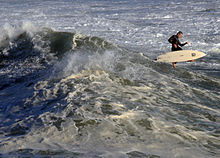

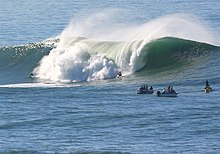

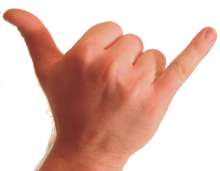


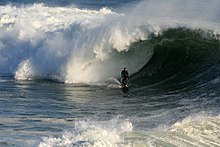

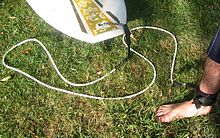

No comments:
Post a Comment